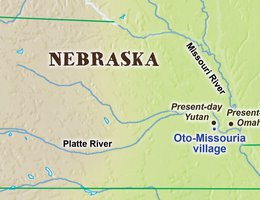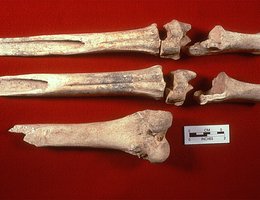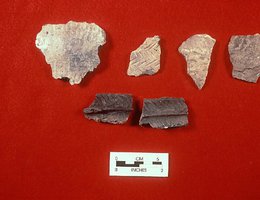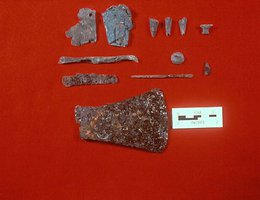
The Oto and Missouria have left impressive archaeological sites, including the Oto-Missouria village near Yutan.
The Otos immigrated into eastern Nebraska about 1700, building the Yutan village about 1775; remnants of the Missourias joined them in the 1790s.The village was occupied until 1837. It was the first major Indian settlement seen by fur traders on the journey up the Platte to western bison-hunting and beaver-trapping ranges. Spanish correspondence from 1777 noted the presence of this site that was named after the Chief Ietan.

The Nebraska State Historical Society conducted excavations at Yutan and unearthed true earth lodges. The earth lodges found at Yutan are circular dwellings and are more advanced in their design than the older, square, wattle-and-daub style house of the Central Plains village farmer. (Wattle is the fabrication of poles interwoven with slender branches or reeds that was used in buildings; daub is the soft adhesive matter used to cover or coat the building, like plaster or mud). The Yutan earth lodges had had from four to 10 central roof support posts around a central hearth. The walls were covered with grass and finally with a thick layer of earth that continued onto the roof. The only opening was a central hole in the roof to allow smoke to escape from the central hearth. A tunnel-like entry passage projected from an east or south wall. Deep subterranean storage and refuse pits outside the earth lodges stored corn and other garden surplus. The village was home base for the entire annual round of activities, but for most of the year the people were away on hunting expeditions.
As we move up the archaeological record, sites like Yutan contain increasing quantities of metal knives, hoes, kettles, and other artifacts obtained from European or American traders. Native American artifacts gradually disappear. Beaver and river otter bones are abundant at the Yutan village. The bones are further evidence that the Oto-Missouria people hunted fur-bearing animals for their pelts, which they then traded to Europeans for manufactured tools and ornaments.
The Eagle Ridge site was a Oto village built on top of an older Plains Woodland burial site. The site is just beginning to provide archaeologists with insights into the life of the Oto tribe.
During the summer of 1998, a housing project was being built on a high bank of Papillion Creek, about two miles east of the town of Papillion. Road graders and other heavy equipment uncovered skeletal remains of ancient humans. When remains like these are found, federal and state laws say that work stops while archaeologists excavate the site and collect the remains for eventual reburial by the appropriate Native American group. The Nebraska State Historical Society Archeology Division was called in to do the emergency salvage excavation.
They found that the skeletal remains were from the Plains Woodland period (2000 to 1000 years ago), and they were part of a burial site. Those remains that survived were carefully collected for reburial.

During the initial exploration, evidence of a more recent protohistoric village was found that dated from 500 to 250 years ago (1500 - 1750 CE). As the excavation progressed, the Society discovered a large number of pits associated with the village. They excavated over 100 pits. Curiously, they could not identify definite evidence of structures or houses built at the village. There were a few scattered post molds that may have been from this period or a more recent farmstead that once occupied part of the site. It appears likely that the structural evidence may have been concentrated near the surface and was removed either by cultivation or the initial grading by the contractor that took place prior to the arrival of the archaeologists.
The type of material recovered and the location strongly suggest an Oto occupation of the site sometime between 1700 and 1750. The site was inhabited by at least several hundred Oto people as evidenced by the type and quantity of European trade goods. The site was a village or base camp, not a temporary camp. The people grew corn and other crops and collected nuts and other wild plants. They fished and hunted deer, elk and birds. Bison do not seem to have been particularly important to their economy.

Although they had access to some European tools, they continued to make stone tools and clay pots. Their primary European trading partners were probably the French.
The most common artifact types found during the excavations were raw materials for ground stone and chipped stone tools, suggesting that sources for both of these were nearby. Finished ground and chipped stone tools were also present in limited numbers. Pottery was quite abundant. Simple stamping as a surface treatment is common and many of the rims are very similar to those found on protohistoric Pawnee Lower Loup sites.
EuroAmerican trade goods were fairly plentiful, generally of the type expected on quite early sites. Included are: glass beads, small brass beads, brass tinkling cones, brass tubes, a brass bell, unidentified brass fragments, an iron hatchet blade, iron knife blades, iron ball ammunition (grape or canister shot), an iron awl (small drill), and unidentified iron fragments.
Evidently, European trading partners were not providing significant numbers of firearms to these Native Americans. Only one incomplete gun part was recovered. It was identified as being from a French Type D trade gun that was introduced about 1730. No gunflints have been identified, yet.
There may also be early 1700s Spanish olive jar fragments. If so, these would be the first colonial Spanish pottery found anywhere in the Central and Northern Great Plains. In any event, it is the oldest example, by a century, of European-made ceramics discovered in Nebraska.

Floral and faunal remains were also present in the pits, in varying amounts. Included among the worked bone items was a quite rare example of a flesher fashioned from a bear femur (see photo above). Red pipestone was quite abundant at the site. The researchers have not yet identified the source of the stone, but it was probably obtained through trade from Minnesota. These stones usually show evidence of having been worked with metal tools.
One of the most important goals of archaeology is to understand why cultures change or remain the same. The Eagle Ridge project offers an ideal opportunity to study rapid culture change, which took place during a dramatic period in the development of the American West. It will certainly offer important insights into protohistoric Oto settlement, subsistence, and technology as well as relations with neighboring tribes and colonial European interests.
The Eagle Ridge investigation is still on-going, but already provides insight into the life of the Native Americans during the late protohistoric and early historic time period. There are still questions waiting to be answered:
How did the introduction of European goods affect the Eagle Ridge people? How did their use of technology change? What changes were there in their subsistence economy and social structure?